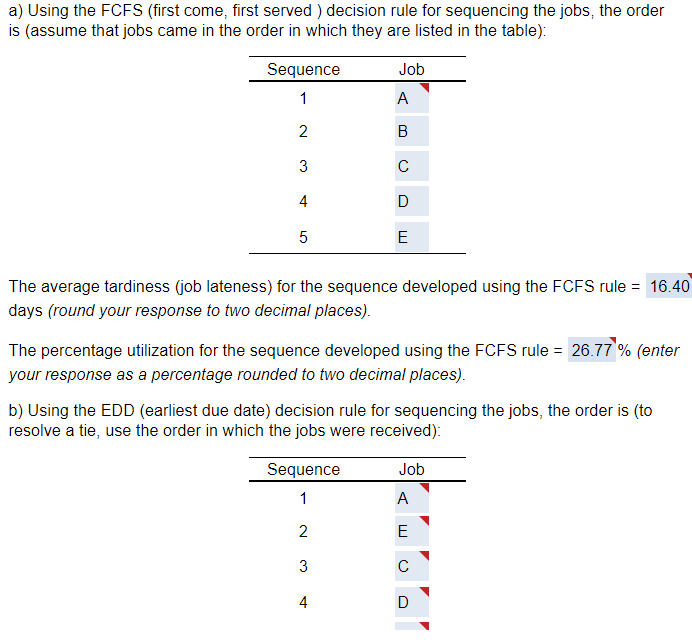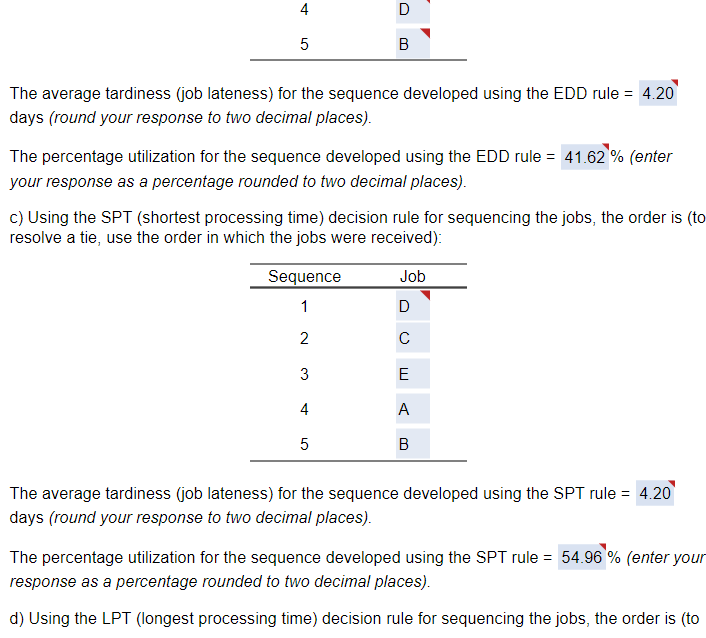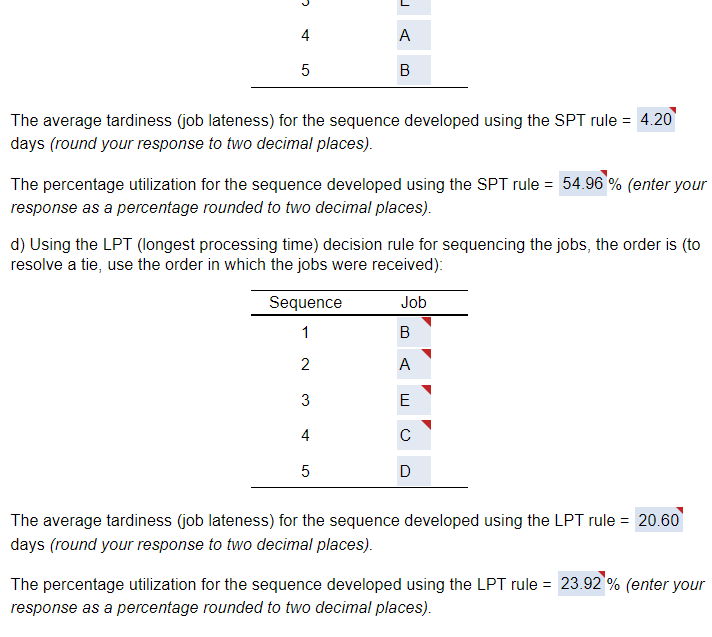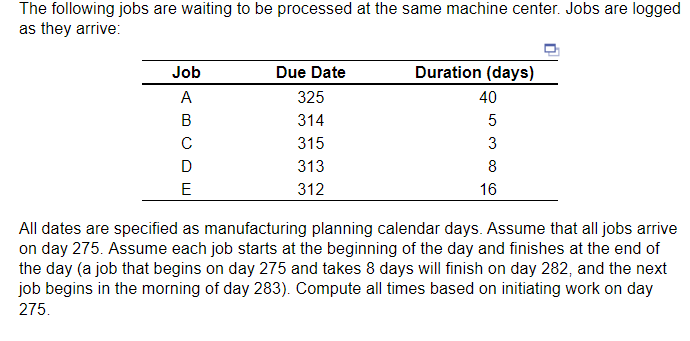Answered step by step
Verified Expert Solution
Question
1 Approved Answer
a) Using the FCFS (first come, first served ) decision rule for sequencing the jobs, the order is (assume that jobs came in the order



 a) Using the FCFS (first come, first served ) decision rule for sequencing the jobs, the order is (assume that jobs came in the order in which they are listed in the table): The average tardiness (job lateness) for the sequence developed using the FCFS rule = days (round your response to two decimal places). The percentage utilization for the sequence developed using the FCFS rule =% (enter your response as a percentage rounded to two decimal places). b) Using the EDD (earliest due date) decision rule for sequencing the jobs, the order is (to resolve a tie, use the order in which the jobs were received): The average tardiness (job lateness) for the sequence developed using the EDD rule = days (round your response to two decimal places). The percentage utilization for the sequence developed using the EDD rule =1 (enter your response as a percentage rounded to two decimal places). c) Using the SPT (shortest processing time) decision rule for sequencing the jobs, the order is (to resolve a tie, use the order in which the jobs were received): The average tardiness (job lateness) for the sequence developed using the SPT rule = days (round your response to two decimal places). The percentage utilization for the sequence developed using the SPT rule =% (enter your response as a percentage rounded to two decimal places). d) Using the LPT (longest processing time) decision rule for sequencing the jobs, the order is (to The average tardiness (job lateness) for the sequence developed using the SPT rule = days (round your response to two decimal places). The percentage utilization for the sequence developed using the SPT rule =% (enter your response as a percentage rounded to two decimal places). d) Using the LPT (longest processing time) decision rule for sequencing the jobs, the order is (to resolve a tie, use the order in which the jobs were received): The average tardiness (job lateness) for the sequence developed using the LPT rule = days (round your response to two decimal places). The percentage utilization for the sequence developed using the LPT rule =% (enter your response as a percentage rounded to two decimal places). The following jobs are waiting to be processed at the same machine center. Jobs are logged as they arrive: All dates are specified as manufacturing planning calendar days. Assume that all jobs arrive on day 275. Assume each job starts at the beginning of the day and finishes at the end of the day (a job that begins on day 275 and takes 8 days will finish on day 282, and the next job begins in the morning of day 283). Compute all times based on initiating work on day 275
a) Using the FCFS (first come, first served ) decision rule for sequencing the jobs, the order is (assume that jobs came in the order in which they are listed in the table): The average tardiness (job lateness) for the sequence developed using the FCFS rule = days (round your response to two decimal places). The percentage utilization for the sequence developed using the FCFS rule =% (enter your response as a percentage rounded to two decimal places). b) Using the EDD (earliest due date) decision rule for sequencing the jobs, the order is (to resolve a tie, use the order in which the jobs were received): The average tardiness (job lateness) for the sequence developed using the EDD rule = days (round your response to two decimal places). The percentage utilization for the sequence developed using the EDD rule =1 (enter your response as a percentage rounded to two decimal places). c) Using the SPT (shortest processing time) decision rule for sequencing the jobs, the order is (to resolve a tie, use the order in which the jobs were received): The average tardiness (job lateness) for the sequence developed using the SPT rule = days (round your response to two decimal places). The percentage utilization for the sequence developed using the SPT rule =% (enter your response as a percentage rounded to two decimal places). d) Using the LPT (longest processing time) decision rule for sequencing the jobs, the order is (to The average tardiness (job lateness) for the sequence developed using the SPT rule = days (round your response to two decimal places). The percentage utilization for the sequence developed using the SPT rule =% (enter your response as a percentage rounded to two decimal places). d) Using the LPT (longest processing time) decision rule for sequencing the jobs, the order is (to resolve a tie, use the order in which the jobs were received): The average tardiness (job lateness) for the sequence developed using the LPT rule = days (round your response to two decimal places). The percentage utilization for the sequence developed using the LPT rule =% (enter your response as a percentage rounded to two decimal places). The following jobs are waiting to be processed at the same machine center. Jobs are logged as they arrive: All dates are specified as manufacturing planning calendar days. Assume that all jobs arrive on day 275. Assume each job starts at the beginning of the day and finishes at the end of the day (a job that begins on day 275 and takes 8 days will finish on day 282, and the next job begins in the morning of day 283). Compute all times based on initiating work on day 275 Step by Step Solution
There are 3 Steps involved in it
Step: 1

Get Instant Access to Expert-Tailored Solutions
See step-by-step solutions with expert insights and AI powered tools for academic success
Step: 2

Step: 3

Ace Your Homework with AI
Get the answers you need in no time with our AI-driven, step-by-step assistance
Get Started


